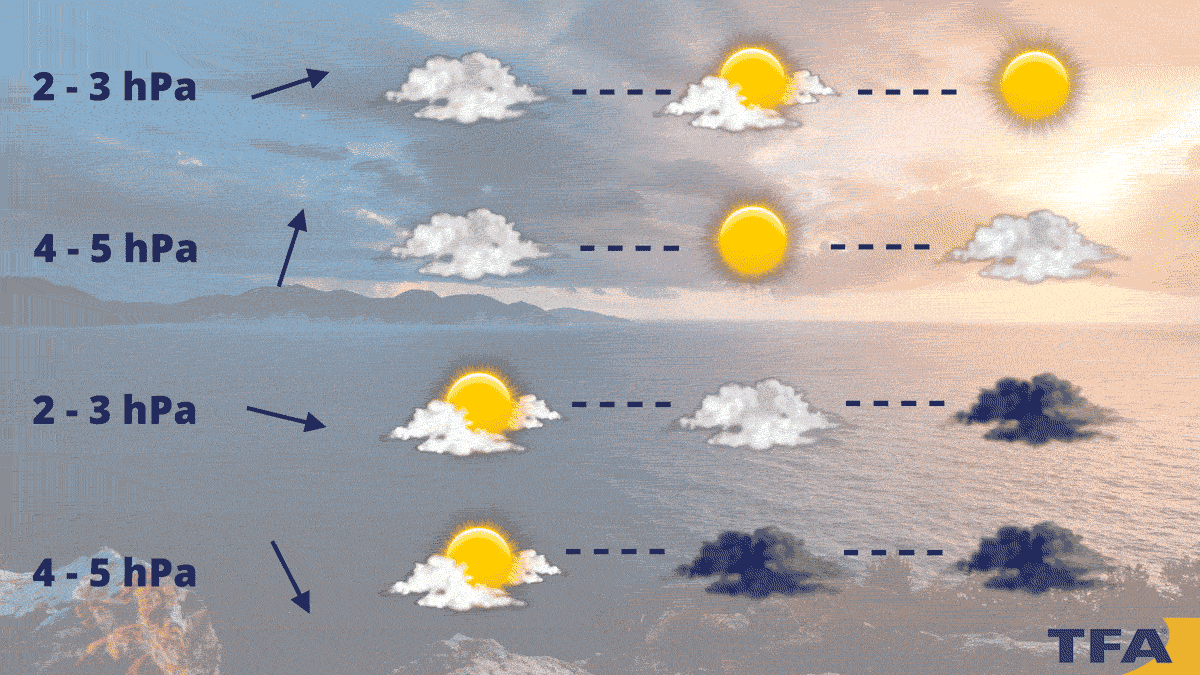Air pressure is the pressure that acts on a body due to the weight of the air column above it. Air pressure is often expressed in bar, where 1 bar = 105 Pa. The average atmospheric pressure at sea level is 101325 Pa (Pascal), which is approximately 1 bar.
An article by weather expert, weather columnist and meteorologist Roland Schmidt.
They were part of the inventory in many households for decades: barometers for determining air pressure. Usually combined with temperature and humidity gauges, they were the forerunners of today’s weather stations, but in their way they were also once “modern”. The fact that air pressure and its fluctuations provide significant information about the weather is still a relatively new discovery.
Discovery of air pressure
It was Evangelista Torricelli who, building on studies by Galileo Galilei, recognised in the middle of the 17th century that falling air pressure led to more clouds and precipitation, while rising air pressure led to cloud dissolution and more sunshine. Shortly afterwards, the French physicist Rene Descartes added a paper scale to the newly developed “barometer” so that longer series of observations could now also be recorded numerically.
This made it possible to fundamentally categorise phases of high and low pressure. However, it was not until the second half of the 18th century that regular weather diaries, such as those kept by the Berlin “weather pastor” Karl Ludwig Gronau, made it possible to understand long-term fluctuations in air pressure and their influence on weather patterns.
Influence of altitude on air pressure
An important obstacle to the use of air pressure measurements was their location-specific nature: the air pressure at a location describes nothing other than the weight of the column of air above that location. This quickly led to the realisation that air pressure decreases with altitude, on average by one percent for every 80 metre increase in altitude. This means that the air pressure in a station at 400 metres above sea level is already 50 hectopascals lower on average than that of a station at sea level.

Sky and clouds. Plane view from the window
Air pressure measurement
Air pressure is measured with a barometer. Barometers are available in various designs and with different operating principles.
A standardised reference system was needed to correlate measurement results at different locations. This was created in the 19th century by converting all measured air pressure values to sea level. This so-called “reduced” air pressure could then be plotted on maps and places with the same pressure could be connected to each other by isobars, lines of equal air pressure.
Air pressure as part of the weather forecast
The invention of the telegraph allowed the international exchange of measurement results and ground weather maps with centres of high and low pressure areas could be drawn for the first time. This was a milestone in meteorological science, as the ground weather map, which was initially produced daily and later even several times a day, became one of the most important instruments for forecasting the weather.
The different weight of cold and warm air currents causes a change in air pressure. Observing the fluctuations in air pressure makes it possible to forecast the weather. The basic structures were clear: high-pressure areas were characterised by sinking air movement, the associated warming of the air and cloud dissolution. In low-pressure areas, rising air caused cloud formation and precipitation through cooling and condensation.
A slight increase in air pressure usually means nicer weather. A rapid rise in air pressure usually means fine weather for a short time. A slight drop in the measured value is often followed by a bad weather front. However, if it drops quickly, this indicates thunderstorms and storms.

Weather forecast by air pressure
It was soon recognised that this process was triggered by the collision of opposing air masses – the model of warm, cold and mixed fronts was born. The wind could now also be determined relatively well, as the pushing of isobars in a confined space indicated a strong air pressure gradient and the resulting storm or hurricane.
Towards the end of the 19th century, weather forecasting became an integral part of daily information, even if the error rate was still painfully high. This changed again with the development of aerology, or high-altitude meteorology, in the first decades of the 20th century. Now weather balloons and soon also zeppelins and aeroplanes provided data from air layers between 2000 and 12000 metres above sea level, and air pressure was also regularly recorded. The picture of air pressure distribution on our planet thus became three-dimensional, altitude lows and highs were determined and their influence on weather patterns described.
However, the more extensive the knowledge of meteorological interrelationships became, the less important air pressure indicators alone became for weather forecasting. The popular barometers became more and more nostalgic fixtures and electronic weather stations took their place. But only for a short time did they still provide forecasts based on the changes in air pressure measured on site; in the meantime, an incessant stream of weather information via the Internet has long since provided all interested parties with the latest news.
Highs and lows, which have long been given proper names, have become clearly visible and understandable characters on the stage of the weather theatre – after all, nothing else can describe the eternal struggle between “good” and “bad” weather so simply and beautifully.